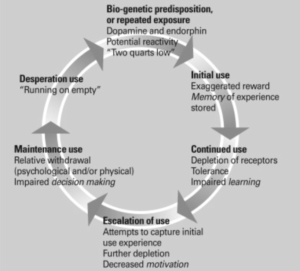Remember, nerve cells are called neurons, and send messages through electrical signals. Essentially, these signals comprise the functioning of the brain and its control over the rest of the body. Each neuron is comprised of a few primary parts: dendrites, which are long fibers that contain receptors receiving signals from other neurons, a cell body, which integrates the signal from the previous (pre-synaptic) neuron, the axon, which contains channels for ion movement and actually carry the electrical signal across the neuron, and synaptic terminals, which turn this electrical message into a chemical one (to be sent to the next neuron).

Basically, signals travel through electrical impulses across individual neurons, but through chemical communication between separate neurons in the form of molecules called neurotransmitters. Neurotransmitters, once released from vesicles (little packaging bubbles the neurotransmitters were contained inside) when the electrical impulse reaches the end of the axon, cross a space called the synapse. Here, they bind to specific ligand-gated receptors on the dendrites of the next neuron, the postsynaptic neuron. “Ligand-gated” is just a fancy way to say some molecule binds to the receptor, causing it to open. When a neurotransmitter binds to a receptor, the receptor opens up, allowing ions to enter the axon of the postsynaptic neuron and sending the electrical impulse through the next neuron. By this method, signals are transmitted from neuron to neuron in different pathways.

The region where most drugs act, the reward pathway of the brain, is located in a region known as the mesolimbic pathway, which begins just above the brainstem at the ventral tegmental area (VTA), travels through the nucleus accumbens, and extends to various limbic system structures – including the amygdala (which controls emotions, their respective bodily responses, and even certain forms of behavioral memory), the hippocampus (which controls long term memory and spatial navigation), and even the prefrontal cortex (which controls higher cognitive functions like decision making and conscious personality).

Since most addictive drugs act here, their use has a very widespread effect. The neurotransmitter used in this pathway is called dopamine; most addictive drugs cause the increase of dopamine in the synaptic space (along with a short, intense burst of pleasure). Because of the amount of dopamine in the synapse, however, the brain thinks the postsynaptic neuron has more dopamine receptors than it actually needs and undergoes a process known as pruning. Here, the amount of receptors decreases, meaning that dopamine release on a normal basis (not in control of the drug) is not enough to both stimulate happiness and facilitate the processes controlled by the various parts of the brain that the reward pathway influences. This creates what is know as a physical dependence – in order for these parts of the brain to even function properly, the drug becomes necessary to produce even more dopamine, compensating for the now-minimized amount of receptors. A lack of the drug begins to adversely affect the brain, and therefore the body, in which case an individual would undergo withdrawal symptoms. Moreover, because each time the drug is taken more and more receptors are pruned, it takes more and more of the drug to reach the same high – and eventually, just to feel normal again – in what is called an increase in drug tolerance. In fact, this is an example of negative reinforcement: taking the drug alleviates withdrawal symptoms, which only makes them worse the next time around. This cycle, for many people, can begin upon first exposure to the drug. Making the wrong first step, with these kinds of drugs, can ruin lives.
